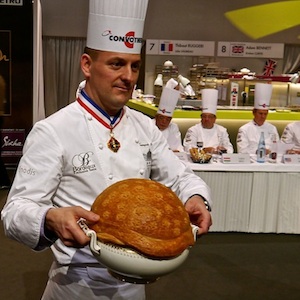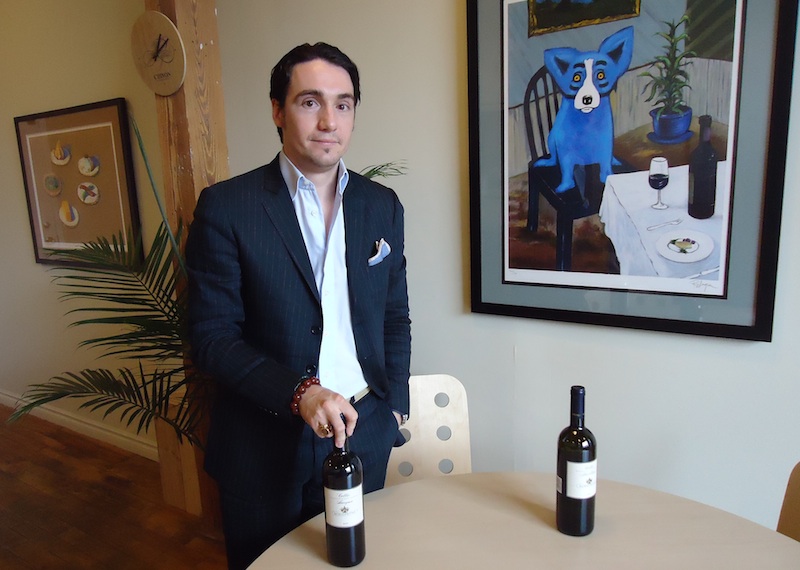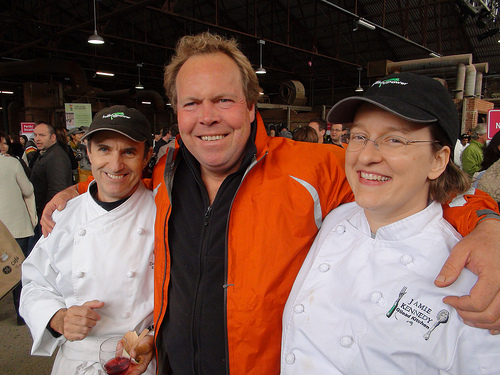by Arelene Stein
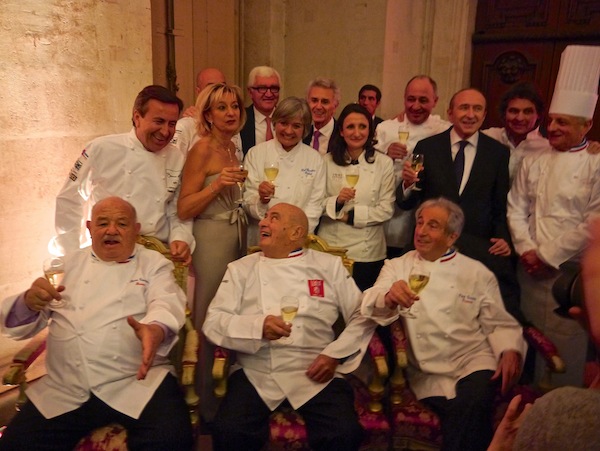
Paul Bocuse recently celebrated his 87th birthday, to the great relief of the culinary community. Last year, an Internet prank had him declared dead and sent chefs around the world into mourning at the loss of this culinary legend. Alas, the 3 Michelin Star chef, Paul Bocuse, is alive and well and continues to command his culinary legacy in Lyon.
(Bo-’who’, you might ask? Well, that comment would signal your gastronomic ignorance and set you down a step or two below any self-proclaimed foodie worth their saltshaker.)
Paul Bocuse is highly regarded amongst the culinary elite as one of the creators of ‘Nouvelle Cuisine’, coined by French culinary critics Gault and Millau when his creations were served to passengers on the inaugural flight of the Concorde in 1969. Bocuse was the original ‘locavore chef’ respecting seasonality of ingredients and a lightness of cuisine, which was not in vogue at the time. His long reign of culinary supremacy has seen many disciples including Jean-George Vongerichten and Daniel Boulud, who started as an apprentice with Bocuse at the age of 14.
In 2011, Chef Bocuse was awarded ‘Chef of the Century’ by the Culinary Institute of America. In Lyon, he holds an almost godlike stature, where his 3 Michelin Star L’Auberge du Pont de Collonges (often just called “Bocuse”) restaurant has become a temple of haute cuisine. Bocuse also owns a chain of Brasseries in Lyon, a restaurant in the French pavilion at Walt Disney World’s Epcot, a culinary academy dedicated to the training of promising young chef talent and has a food hall named in his honour. Simon Hulstone, a highly accomplished chef in the UK, and that country’s representative at the 2011 Bocuse d’Or) has stated, “Bocuse is without a doubt an icon of gastronomy, (he’s had) 3 Michelin stars since 1965 and (is) the one chef that all chefs respect.”
Chef Bocuse has dedicated his life to the industry of gastronomy and ensuring the recognition of the trade for their hard work, creativity and passion by creating the Bocuse d’Or. One of the biggest hallmarks of his own success was his ability to respect and motivate his team and in particular, focusing on training young talent.
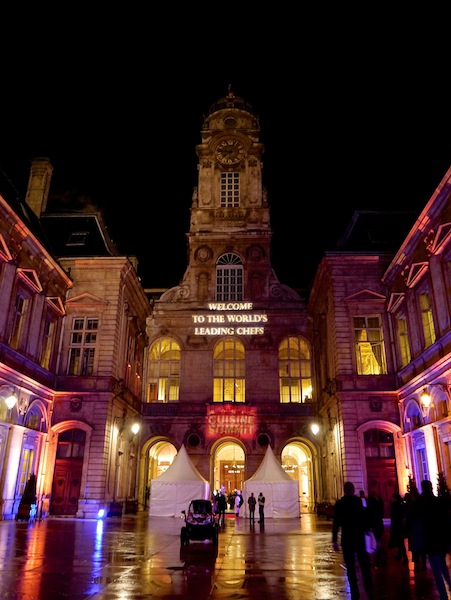
In January 1987, Paul Bocuse created the Bocuse d’Or, which at that time was a revolutionary gastronomic competition. He conceived the event to be carried out similarly to an Olympic sporting competition. Since then, the format of culinary competitions has become a pop-culture template for foodie fascination. Today millions of viewers eagerly watch chefs compete against each other in ‘reality’ network shows like the ‘Iron Chef’ franchise and ‘Top Chef America’. This original chefs challenge was developed to invite 24 of the world’s most promising young chefs to compete for the ‘Best Chef in the World’ in front of a live audience. The competition has a Eurocentric representation with 12 of the designated candidates being from the Continent. The event is held biannually on Bocuse’s home turf in Lyon France, carried out in conjunction with Sirha – Europe’s most popular food trade show, which brings in over 175,000 visitors over five days in late January.
All levels of French government support the event and the opening ceremony is held in the regal courtyard of the City Hall of Lyon. Having the privilege of being able to attend the Chefs’ reception was the equivalent of being able to attend the culinary Oscars. The event is attended by culinary royalty including top name chefs from around the globe including Thomas Kellar, Daniel Boulud, Alan Ducasse and of course the legend himself. When Paul Bocuse made his grand entrance, accompanied by his son Jerome, you might have thought Brad Pitt had made an entrance into the room given the frenzied paparazzi that followed him on his short journey to his throne. The atmosphere was electric with the energy of such a revered collection of culinary titans.
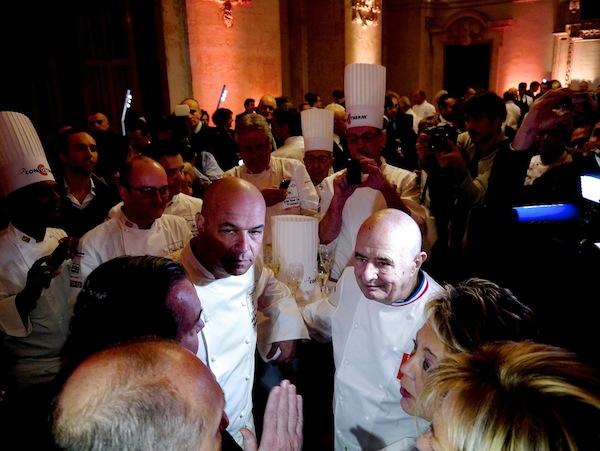
The Bocuse d’Or competition is carried out over two days, with 12 teams competing each day. The competitors are given fivehours to prepare two dishes and then positioned to deliver each of their creations with 20 minutes between courses. As a spectator, it is a marvel of confusion as plates are executed with pomp and pageantry showcased to the crowds and then delivered to the judges in rapid succession. Only the judges are ever able to taste the food. The judges are divided into two panels with one side judging the fish course, while the other side samples the beef plates. The rules are simple – deliver a perfectly executed dish that you have been practicing for over a year, with the measure of its greatness being taste, texture and temperature. Scoring is divided equally between the two main dishes with extra kitchen points awarded for teamwork, ensuring adherence to predefined recipes and minimizing waste.
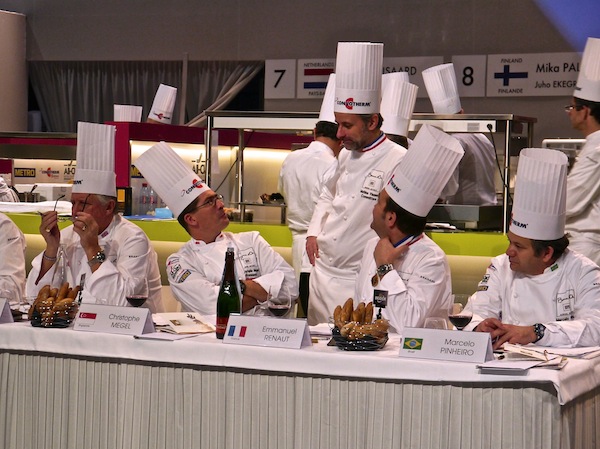
I had to wonder, what was the point of the Bocuse d’Or? This after all was a competition where each chef was given the opportunity to perfect his or her dishes for upwards of a year. Competitors often take a leave from their current work to focus full time on preparing for the event, alongside a team manager, a coach and a commis. Given that amount of time, training and support afforded each chef, I imagined that I could possibly have been a viable candidate. Nevertheless, athlete’s train for most of their lives for the honour of competing in the Olympics, so I suppose it’s realistic to expect that chefs chosen to represent their selected countries would dedicate a year of their lives to preparing for such a challenge. Chef Robbrecht Wissels from Belgium went so far as to hire a personal trainer to ensure he was also in top form to be able to handle the physical stress of the of competition.
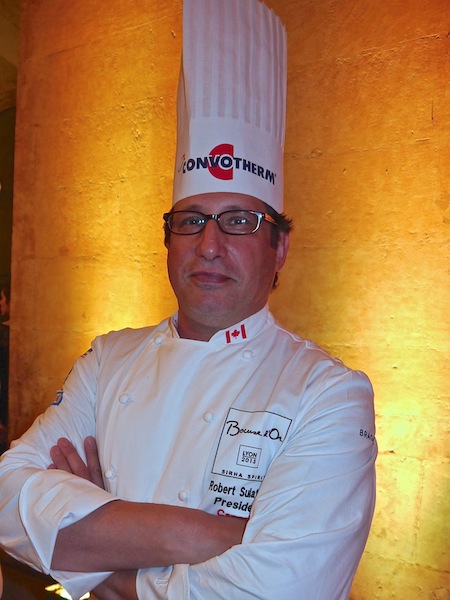
The Canadian judge Robert Sulatycky, who competed in the Bocuse d’Or in 1999, holds the title of the highest-ranking North American Chef, in the competition, at 4th place. (Canada has sent a competitor to every competition since the inception of the event in 1987). When I spoke with him he upheld the event as a relevant venue for young chefs, especially in Canada, as “it helps them to develop discipline as a chef, that in Canada is difficult to obtain.” After having participated in the Bocuse d’Or for over 16 years and currently residing as the President of the Canadian chapter, he believes fully that the competition, “pushes your skills to a new level and challenges your creativity as a chef.”
In assembling their team, chefs must select a commis (assistant), who must be under 22 years of age at the start of the Bocuse competition. The very young Jack Beers, who is a mere 18 years old, served Canada’s representative, chef Alex Chen. Chef Jonathan Gushue from Langdon Hall recommended Beers for the position, where he had done an apprenticeship throughout high school for more than two and a half years. When he was selected, he moved to the west coast of Canada to begin training, keeping up a job at the highly renowned Hawksworth Restaurant in Vancouver. As the completion date came closer, he gave up his job to focus solely on training with chef Chen.
As an ambitious young cook, Beers feels that the experience he gained by training for the competition has been invaluable to his future development. He explained:
“Being able to work that closely with a chef of Alex’s distinction and caliber, allowed me to advance quite quickly in terms of my own skills and ability. I learned a lot of wisdom from Alex who has become a mentor. We were constantly testing ingredients, going to markets to source different products, cooking items repeatedly to see how they worked and refining our technique. I was introduced to flavor profiles that I’d never thought of – Alex taught me how to taste and smell properly and generally become a better cook.”
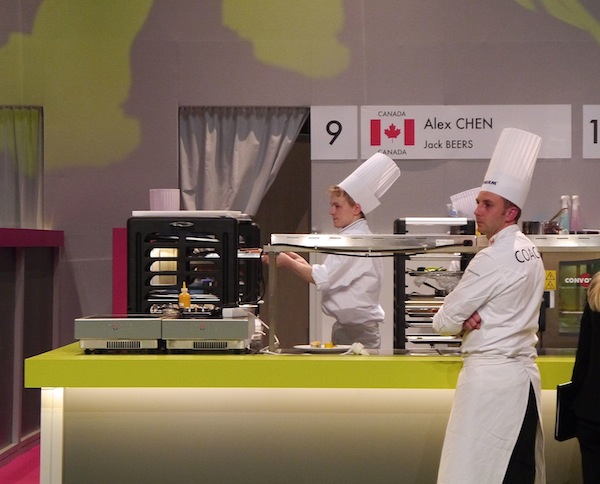
When asked what he thought about the experience of competing in front of a live audience for thousands after many months of training in a sequestered kitchen on the west coast of Canada, Beers replied, “It was an adrenalin rush, my heart was racing when we first started and it took over an hour to calm down and find my groove. I really loved the competition and would love to compete again as a commis and eventually as a chef competitor. I’d like to eventually be the first chef to bring home a trophy for Canada.” For now, Beers will use the connections he gained through his participation in the competition, to do a culinary stage at Geranium Restaurant in Copenhagen, under the tutelage of Rasmus Kofoed, the only Bocuse contestant to take the podium three times earning a Bronze, Silver and eventually the Gold in 2011.
The competition culminates at 5:30 p.m. at the end of the second day. Awards are given out for the best meat dish and best fish dish – both consolation prizes. It is generally understood that chefs receiving those awards will not stand on the podium. This was reflected in the disappointed face of Norwegian Chef Ørjan Johannessen as he accepted his award for best fish dish.
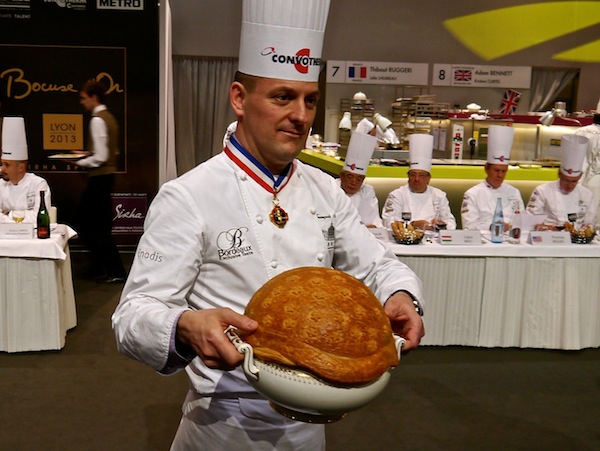
This year France was the clear favourite with a considerable lead over Denmark who took Silver. Thierry Ruggari, the French competitor pulled out all the stops and served Paul Bocuse’s signature truffle soup, as one of his sides, perhaps in an attempt to charm the judges and honour the ageing Bocuse. The Japanese team was clearly going to get a podium spot with their clever and innovative take on a bento box and was awarded the Bronze. Team Canadian placed 9th overall, which was not a bad place to land in a fierce competition of over 24 countries.
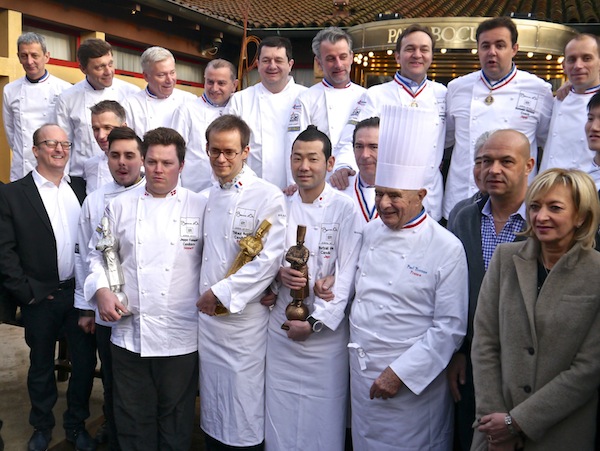
The winning chefs were celebrated the following morning, after the requisite Champagne soaked after party, with a buffet breakfast at L’Auberge du Pont de Collonges. It was not just the winner who celebrated Chef Ruggari’s victory, but the entire French contingent and perhaps all of France, but most of all, the great Paul Bocuse himself. As Bocuse walked to take his place beside the chef champions, at the ceremonial breakfast, you couldn’t help but see the radiant pride and sense of well-deserved accomplishment for his ability to inspire and encourage young talented chefs to become the best that they can be.
 Arlene Stein is the Chair of the Terroir Symposium, April 8 in Toronto. She reports on European culinary events for GFR. Follow her at @TerroirTalk.
Arlene Stein is the Chair of the Terroir Symposium, April 8 in Toronto. She reports on European culinary events for GFR. Follow her at @TerroirTalk.

